The Lake George Association posted a video of their conservation efforts from 2019 which includes a great segment about their work replacing the ‘firehouse’ culvert in Huletts Landing. Many thanks to the Lake George Association and their benefactors for their work in the Lake George basin.
October Dresden Town Board Meeting Minutes
The minutes for the October 2019 meeting of the Dresden Town Board were recently approved and have been posted on the town’s website. There are many interesting items in this months minutes.
Fifth Annual King George Fishing Derby
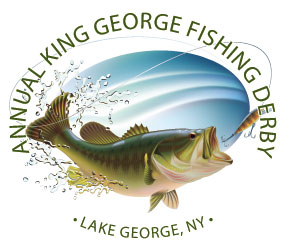
Love to fish? Lake George is ready for the fifth annual King George Fishing Derby on September 13th -15th. Are you ready? Prizes awarded for the heaviest fish in the following four categories: Lake Trout, Landlocked Salmon, Largemouth Bass and Smallmouth Bass
Join hundreds of other anglers and get your entries in during September 13th -15th.
You can find the entry form – electronic or in PDF form – on the event’s website at http://www.KingGeorgeFishingDerby.com
Adults and children are invited to compete, as there are separate divisions for each. Cash prizes for the adult division are $2,000 for first place, $1,000 for second, $500 for third, and $250 for fourth.
Adults can register for $50 and juniors can register for $30. FREE event T-shirt with early registration by August 31, 2019
For more information, please visit the event’s website at KingGeorgeFishingDerby.com or email info@kinggeorgefishingderby.com
July Dresden Town Board Meeting Minutes
The minutes for the July 2019 meeting of the Dresden Town Board were recently approved and have been posted on the town’s website.
June Dresden Town Board Meeting Minutes
The minutes for the June 2019 meeting of the Dresden Town Board were recently approved and have been posted on the town’s website.
DEC Forest Ranger Rescue near Montcalm Point
On July 30 at 9:21 p.m., Warren County 911 transferred a call to DEC’s Ray Brook Dispatch from two young women who were part of a group from Camp Chingachgook who had lost the trail when they went to retrieve water from the lake on their way to a campsite near Tongue Mountain Range. Using the coordinates obtained through 911, Dispatch was able to place their location just north of Montcalm Point on Lake George. Forest Rangers Charles Kabrehl and Arthur Perryman responded to Green Island, where they took a boat out to Montcalm Point. At the request of Forest Ranger Kabrehl, Dispatch contacted the initial caller and instructed them to head back downhill towards the western shoreline. At 10:49 p.m. the Forest Rangers found the 16-year-old from Davidson, N.C., and the 17-year-old from Troy along the shoreline where the Rangers picked them up and took them back to their camp.
Congresswoman Stefanik Announces $500,000 in Funding for New Lake George Wastewater Facility

Congresswoman Elise Stefanik (at podium) with Walt Lender,
Executive Director of the Lake George Association, NY State Senator, Betty Little, and Lake George Village Mayor, Robert Blais. (Click image to see larger view.)
Last week, Congresswoman Elise Stefanik announced $500,000 in grant funding for the Northern Border Regional Commission to build a new wastewater treatment facility, which is under a consent order by New York State DEC to be replaced by Fall 2021. The current facility has been in operation since 1939.
“I’m thrilled to announce $500,000 in funding for the Northern Border Regional Commission to build a much needed and modernized wastewater treatment facility,” said Congresswoman Stefanik. “I have been a consistent advocate for the NBRC since day one in Congress, and I’m proud to have been able to deliver this important result for the community, and will continue my efforts to revitalize our region.”
“We greatly appreciate Congresswoman Stefanik’s support in this vital project, to insure “The Queen of American Lakes” will be protected and enjoyed for many generations,” said Lake George Village Mayor Blais.
Many thanks to Congresswoman Stefanik and all those who made this funding possible.
Gov. Cuomo Water Skis on Lake George
This was posted on the Governor’s Instagram account:
Big Fish That Did Not Get Away
It’s always interesting to see our fisherman friends hold up their “catch of the day.” Lake George has some of the best fishing around so it’s nice to see the folks who can reel them in. Many thanks to Gavin Rodgers and Vinny Benvenuto for sharing these great pictures.
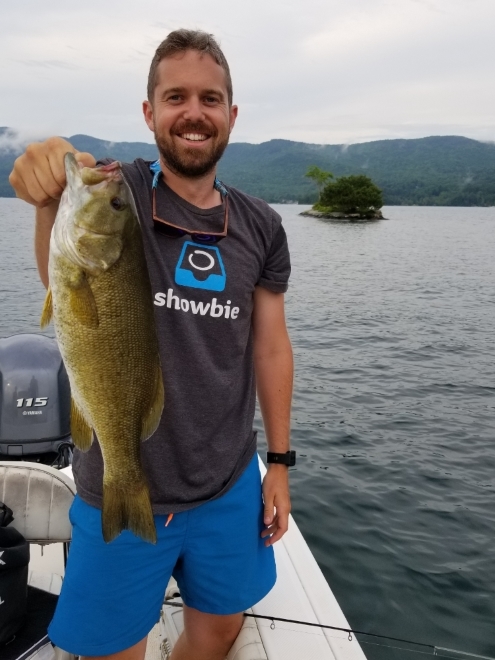

An Artful Landing
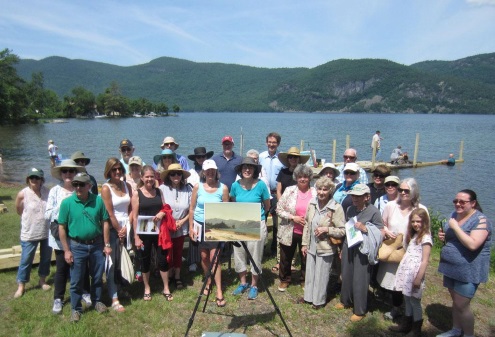
A number of art enthusiasts came to Huletts Landing by boat to find the location that a famous painting was created from.
An art history cruise visited Huletts Landing Monday June 24th, arranged by the Albany Institute of History and Art under the direction of artist Anne Diggory, whose exhibition is at the museum until August 18th.
The group came on shore to view the perspective that David Johnson depicted in two paintings in 1870 and 1874. The 1870 version is in the collection of the museum.
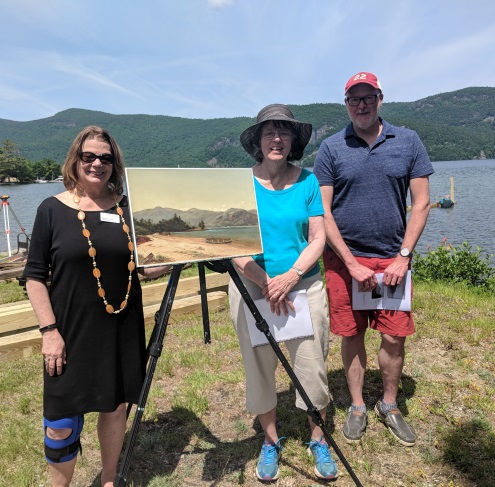
Posing with a reproduction of the painting are Tammis Groft, Executive Director of the Albany Institute of History and Art; Anne Diggory, tour director; and Doug McCombs, the museum’s Chief Curator.
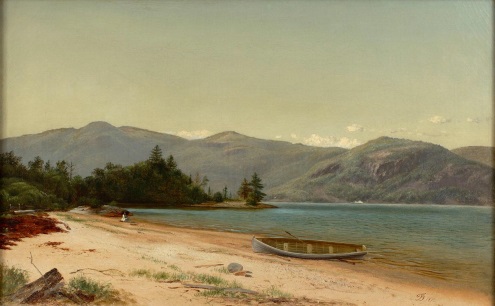
The 1870 version of the painting by David Johnson.
LGLC Announces Appointment of Clifford David, Jr. to the Board of Directors

Clifford David, Jr.
The Lake George Land Conservancy (LGLC) announced the appointment of Clifford David, Jr. its Board of Directors.
David has been involved in land conservation for over 30 years. He has extensive experience in non-profit, government and private sectors, with a focus on blending conservation and economic development. David has been coming to the Lake George region for more than 40 years, including as a Bolton resident during the last 20.
On joining the LGLC Board, David said, “I have always believed that it is important to support and be involved in organizations that align with my values. The LGLC brings together my deep interest in protecting our ecosystem while enhancing the communities’ interests and uses of this beautiful watershed.”
“Cliff brings extensive experience in the field of land protection to the LGLC,” said LGLC Executive Director Jamie Brown, “from the operation of land trusts and organizational management, to the implementation of land protection on large landscape and watershed-scale levels, and project development for businesses that maximize conservation outcomes. I am confident that he will be vital part of our work and make a positive impact on the Lake George watershed.”
David is the President and CEO of Conservation Economics, a consulting company that provides services to corporate and individual landowners who wish to monetize the value of their property while protecting its natural and historic resources. David has a B.S. in Botany from the University of Vermont, and a M.S. in Organization and Management from Antioch College. He serves on many for-profit and non-profit boards and councils in the greater Philadelphia region of Pennsylvania.
PBS features LGLC’s HWA Monitoring
In March, Lake George Land Conservancy Conservation Manager Monica and Land Steward Alex guided the Crooked Canes hiking group on a walk through the LGLC’s Cat & Thomas Mountains Preserve to look for the invasive pest Hemlock Woolly Adelgid (HWA), a tiny, destructive bug that has found its way to the Adirondacks. If it spreads, the Hemlock Woolly Adelgid (HWA) could threaten millions of Hemlock trees throughout the Adirondack Park.
Mountain Lake PBS‘s Thom Hallock joined in on the hike. View the video below!
Some Leftover Snow But No Ice

Some leftover snow in the foreground but the Lake is now free of ice.
According to the Lake George Association and RPI’s Darrin Fresh Water Institute, the official ice out date for Lake George in 2019 was Saturday, April 13th.
Also according to the LGA, the official ice-in date was on January 22, meaning Lake George had 81 days of ice in 2019.
That total number of days (81) is about five days more than the average ice-in period since 2000, though it is two days fewer than average when compared to ice-in dates since 1950 (of the years where the Lake was fully iced in).
As you can see from the above picture, there are some small spots of snow here and there but the ice is gone from the Lake. Hopefully, you will be back soon!
Art Exhibition at the Albany Institute – Anne Diggory – All in a Day’s Work

Out of Place in Huletts Landing, Anne Diggory, 2018, hybrid on canvas, 21″ x 31″, artist collection
New Exhibition
Anne Diggory: All in a Day’s Work
April 6 – August 18, 2019
Discover Anne Diggory’s newest exhibition this Saturday at the museum!
Artist Anne Diggory paints nature’s multiple expressions in the context of both contemporary and historic approaches, such as the Hudson River School. The exhibition, Anne Diggory: All in a Day’s Work, features eighteen lakeside landscapes, the products of Diggory’s intense concentration on a motif that often yields several works from a single day on location.
Sunday Lecture
All in a Day’s Work
Sunday, April 7, 2pm
Anne Diggory will discuss artistic choices in her own work as well as in those of nineteenth century painters David Johnson and John Frederick Kensett, whose motifs are included in several pieces in her exhibition All in a Day’s Work.
The whole show can be seen at: http://diggory.com/images/exhibitions/dayswork.html
